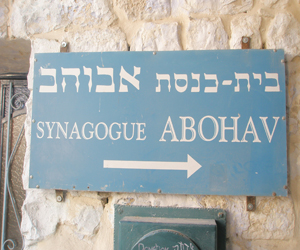Abuhav Synagogue
It is not clear which of the two rabbis named Yitzhak Abuhav inspired the naming of this synagogue and that of the famous Torah scroll attributed to one of them. Popular tradition links the synagogue with the author of Menorat Hama'or, a well-known work on ethics. But it is more likely that the synagogue is named after the fifteenth-century rabbi who is considered one of the gaonim - great sages - of Castile. He served in the rabbinate in Toledo and headed a yeshiva for the study of Jewish philosophy and Kabbalah. Among his pupils was Rabbi Ya'acov Beirav, who later moved to Safed and became one of its foremost sages. It may have been Beirav who brought the Torah scroll attributed to Abuhav to the synagogue.
The Oldest Torah Scroll
The scroll housed in the Abuhav Synagogue is the oldest in Safed and many traditions and legends are associated with it. It is kept locked up in the Ark and is only taken out for reading three times a year: Yom Kippur, Shavuot, and Rosh Hashanah. Another Torah scroll in the Abuhav Synagogue is the scroll of Rabbi Solomon Ohana, a Kabbalist from Fez, Morocco, who moved to Safed in the sixteenth century. For generations, the Jews of Safed gathered in the synagogue on the eve of Shavuot to celebrate the giving of the Torah to the Jewish people. It was also customary at weddings to bring the bride to the synagogue accompanied by music, dancing, and singing.
A Bit Of History
The synagogue was built in the sixteenth century and its southern wall contains three Arks. The bima is in the center and the benches for the congregation are arranged around it, as was customary in ancient synagogues.The interior of the synagogue dome is decorated with depictions of musical instruments that were used in the Temple in Jerusalem, symbols of the tribes of Israel, and four crowns, representing the Torah crown, the priestly crown, the royal crown, and a crown unique; to Sated: "the crown of impending redemption." in keeping with the numerological tradition of Kabbalah, the design of the synagogue has numerical significance: one bima, two steps to it, three Arks, and so forth. The works of well-known Israel artist Ziona Tagger adorn the walls.

